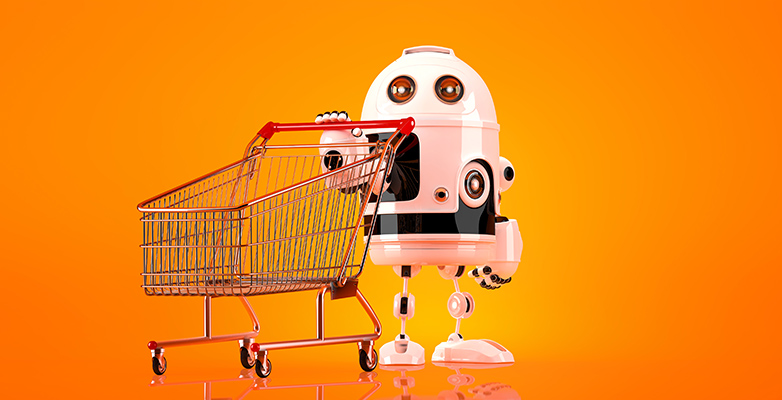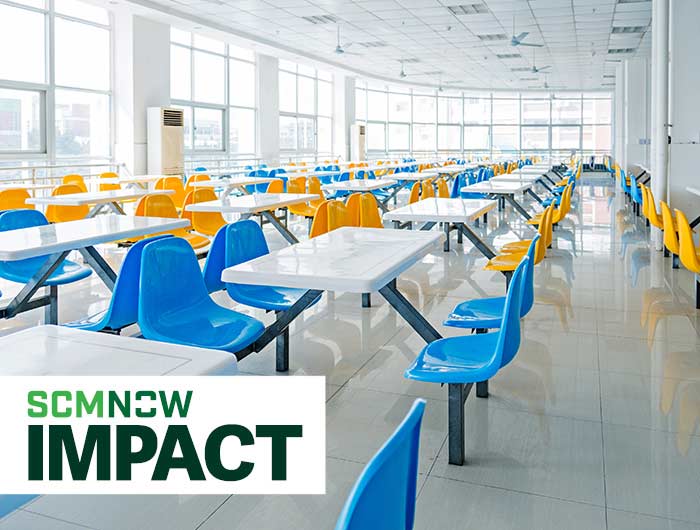Grocery shopping, though a necessary part of life, can be a chore. You write a shopping list, perhaps check the supermarket website for what’s on sale, try not to forget your reusable shopping bags, drive to the store, fill your cart, wait in the checkout line, scan your coupons or loyalty app, pay, load your groceries in your car, drive back home, and put everything away. Week after week, month after month, year after year. It’s no wonder that retailers and food companies are always looking for ways to make shopping more exciting and convenient.
Decades ago, customers used to place their grocery orders at a store counter and wait for clerks to bring their items to them. As you can imagine — or maybe you can remember — shopping became more exciting when stores grew to include aisles of goods customers could have the joy of selecting themselves. Shoppers could pick exactly which loaves of bread, pieces of fruit, and boxes of cereal they wanted and maybe discover some new ones along the way. Since then, grocers have continued to add new enticements, including delicatessens, coffee shops, prepared meals, frozen foods, kiosks with samples and self-checkout stations.
Ironically, many stores offer a service that harkens back to the old way of shopping: Customers place their orders online and a clerk selects their products and prepares them for pickup. Many retailers also have home-delivery, which A&P offered back in 1930 (Lewis 2018).
But consumers still want more:
- They expect food to be available when, where and how they want it. Because consumers are increasingly time-strapped, they want to get their food faster and in a form that requires minimal preparation because they don’t have hours to spend cooking. They also want to order their food as frequently as they need it, rather than having to spend time creating a long grocery list and shopping just once a week. If a given store can’t deliver on these needs, customers will go elsewhere.
- They want quality items. Consumers expect stores to offer high-quality, fresh groceries that have been handled and stored safely to prevent the spread of foodborne illnesses. On top of this, they want packages to clearly label allergens, highlight the origin story of the product and call out any undesirable additives.
- They want more value for the same price. Consumers are demanding greater food variety, higher quality, faster deliveries, ready-to-eat meals and more, but they do not want to pay extra for these features. Consequently, all members of the food supply chain must work to reduce or control their costs.
Consider The Complexities
These are tough demands on an industry that already is operating with tight margins. Sometimes it seems as though the best option is to automate more processes. Soon there could be drones handling agricultural responsibilities, 3D printers making food, robots roaming store aisles handling the e-commerce grocery fulfillment process and driverless trucks delivering orders. These innovations certainly could save money and offer greater convenience in the long run.
The main challenge, though, is that food supply chains are so complex. For starters, the origins of different foods vary widely. Locations can be everything from large, standardized wheat fields to backyard berry patches. They can be owned by large corporate conglomerates or individual families. Some producers may use pesticides or growth hormones while others prefer more organic approaches. Caring for livestock and watering, monitoring and harvesting crops may be done by hand or with the help of the latest technologies. Regardless of the point and method of origin, all of these of products become a part of a food supply chain.
After the food has been grown, it must be processed to make it edible. Slaughterhouses trim meat and package it into sellable sizes. Canneries wash, size and seal vegetables in cans. Processors transform cereals, sugar, flour and spices into a variety of consumer packaged goods. Juice houses squeeze fruits and bottle the drinks for convenient consumption. In short, each food preparer has its own method, challenges and considerations.
From this stage, food makes the journey to the retail channel. Some items cross borders, undergo inspection and basically receive the proper credentials to enter the country of sale. Other items require careful refrigeration or freezing and temperature monitoring. In addition to these challenges, distributors must be able to move products to the right place at the right time to meet consumer and retailer demands.
Food can be sold to consumers through a variety of retailers, including farm stands; small, local grocery stores; large chain grocery stores; mass merchandisers such as Walmart and Target; club stores; dollar stores; gas stations; convenience stores; e-commerce retailers; and more. Then, the food finally reaches the consumer.
But this isn’t the end of the supply chain. There still is waste management and recycling. Of course, municipalities typically process the discarded packaging materials after individuals consume the foods and beverages, but retailers and their waste management services also must process the waste from food that is not sold or consumed. Baked goods, cooked meats, and fruits and vegetables have relatively short shelf lives and need to be disposed of frequently. Some stores may donate the food to homeless shelters or other community organizations, but anything that is deemed unfit for human consumption must be discarded. Nelson (2018) estimates that one-third of the food produced in the world for human consumption — or 1.3 billion metric tons — gets lost or wasted. Interestingly, “Much of the food waste produced around the world can be traced back to inconsistencies in the supply chain: inventories aren’t recorded, suppliers aren’t informed and quality isn’t taken into account,” he writes. Blockchain could help create more accurate supply chains and reduce this waste. However, at present, most retailers do not have programs in place to report on or reduce their food waste (Redman 2018).
Improving entire food supply chains is difficult because there are so many partners that need to handle a given product through its life cycle. Each network tier also incorporates a wide variety of business models that handle their step of the process differently. Because of this, it is challenging to achieve total alignment.
Automated Approaches
The use of automation and artificial intelligence, especially in the form of robots, is increasing throughout the food supply chain. GPS-based applications help farmers with crop planning; field mapping; soil sampling; planting and fertilizing; tractor guidance; crop scouting; variable rate applications; yield mapping; and working in low-visibility conditions, such as rain, dust, fog and darkness (National Coordination Office for Space-Based Positioning, Navigation and Timing 2018). Farming tools now come equipped with sensors that help determine how much fertilizer is needed for the soil and when to water crops. Automatic weeders and harvesters help farmers produce crops more efficiently. Fruit farmers are especially interested in new automatic fruit-picking equipment that can prevent bruising. Several companies are working on next-generation picking machines that move autonomously and handle these delicate items, but all are years away from commercialization (Strong and Hernandez 2018).
In the delivery arena, companies are eagerly awaiting the availability of driverless vehicles to help meet demand for more frequent deliveries. Cincinnati-based grocery chain The Kroger Co. recently announced a partnership with self-driving car startup Nuro to test driverless grocery deliveries. Kroger executives expect that large-scale driverless deliveries, which still are years away, will make the delivery service cheaper and easier to introduce in more rural parts of the country (Haddon 2018a). Drones also are being considered as a delivery vehicle, especially for small, light packages to more remote areas (Haddon 2018b).
At the retail level, Boise, Idaho-based Albertsons Companies has started piloting a micro-fulfillment center concept powered by Takeoff Technologies’ artificial intelligence capabilities. The Waltham, Massachusettsbased technology company’s fulfillment model receives customer orders through an e-commerce interface, uses artificial intelligence-enabled technology coupled with a system of totes and conveyors to pick the items from the store’s inventory, and delivers the orders to a store employee. The human employee checks and finalizes the orders and gives them to customers. When installed, this should greatly reduce the amount of time required for processing individual orders.
The Power Of Data
To support robots and artificial intelligence, technology experts also are moving forward with data collection and analysis innovation. Although bar codes still are the dominant method of identifying and tracking items within the supply chain, radio-frequency identification technology is being considered as a means to collect and provide more information (Roberti 2018). To gather data about various processes, sensors are being added to tools that are connected to the internet of things. Artificial intelligence techniques can interpret this data and stimulate corrective or improving actions.
On an even larger scale, blockchain technology is being developed to more securely integrate supply chain data networks. The agriculture and food supply chain’s global investment in blockchain was estimated to be $60.8 million in 2018 and is expected to grow to almost $430 million by 2023, a compound annual growth rate of 48 percent, according to Reportlinker. The two major drivers for this growth are the intensifying demand for solutions that can help attain complete traceability of food products and the increasing instances of food fraud.
Culinary Creations
New technologies also are enabling culinary innovations. For example, some food companies are experimenting with 3D printing to create shaped food items, such as chicken nuggets in the shape of dinosaurs or stars (Gasparro and Newman 2018).
To improve traceability, other businesses are experimenting with edible bar codes. Made by combining segments of seaweed DNA, the bar codes are invisible and tasteless (Gasparro and Newman 2018).
More In Store
More innovations are going to be required toward the end of the food supply chain. With Amazon and other e-commerce giants offering grocery delivery, retailers are realizing that they too must provide online ordering, order pickup and grocery delivery to compete. With 70 percent of consumers buying at least some groceries online within the next five years (Lewis 2018), the presence of human or robot order pickers could clog store aisles and make it difficult for people to shop. Plus, if the magnitude of online ordering is great enough, it may cause inventory stockouts until retailers adjust to the new business model.
Omnichannel grocery shopping will also require retailers to become distribution experts. Although e-commerce represents less than 5 percent of U.S. grocery sales currently, food and beverage sales are growing far faster online than in supermarkets. Forrester Analytics predicts that, by 2022, the U.S. online grocery market will total $36.5 billion, up from an estimated $26.7 billion in 2018 (Haddon 2018c). This means retailers will need to deliver quality food items when and where the customer wants it while keeping prices low. With that challenge still ahead, the food industry is ripe for more technology innovation.
For a list of annotated references about this subject, contact the author at crandllre@appstate.edu.



